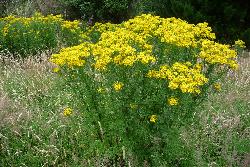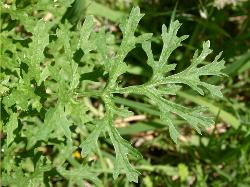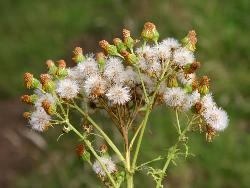- Taxon
- Weed
Habitat: bank, coast, dry, forest, forest edge, gap, grassland, gravel, hill, log, lowland, margin, moist, open, pasture, peat, ridge, riparian, river terrace, riverbed, roadside, sand, shaded, slope, stone, terrace, track, wasteland
Dispersal: Seed
Recognition
- an upright and long-lived herbaceous plant that forms a basal rosette of leaves during the early stages of growth.
- it later produces one or more upright stems that are much-branched towards the top of the plant.
- its deeply-divided leaves are dark green and mostly hairless above, and somewhat paler and hairy underneath.
- its bright yellow flower-heads (20-25 mm across) are borne in dense clusters at the tops of the branches and have 12-15 elongated 'petals'.
- the bases of the flower-heads are surrounded by about thirteen small greenish bracts that have black or brown tips.
- it gives off an unpleasant smell when damaged.
[From: Environmental Weeds of Australia]
Images
References
Biosecurity New Zealand 2012: Regional Pest Management Strategies Database. http://www.biosecurityperformance.maf.govt.nz/
Connor, H.E. 1977: The Poisonous Plants in New Zealand. Edition 2. Government Printer, Wellington. [as Senecio jacobaea L.]
Howell, C. 2008: Consolidated list of environmental weeds in New Zealand. DOC Research & Development Series 292: 42. [as Senecio jacobaea L.]








